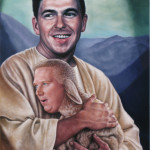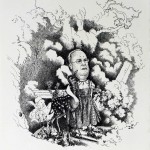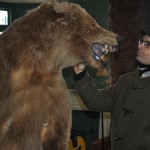MC: My early work reflected internal reflections. As an adult, I went through a life shift– I became more interested in looking out at the world. Understanding my identity is not separate from the history or the moment I live in or the place I am living in. I want to have some type of relationship to that. Earlier in my career I may have been more attracted to gender and male identity. But now my practice is in an adult realm that bridges the internal with the external. It’s a more comprehensive approach to art-making.
BTB: How would you describe your style?
MC: A friend at work called it, “Magic Literalism.” I like that.
BTB: What is your point of view on American politics?
MC: I am not very sophisticated in my politics. I also don’t like the Canadian point view of Anti-Americanism; it’s a knee jerk. As a Canadian and as a citizen of the world, we’re all affected by American politics. All of us absorb so much media that we tend to feel impotent in big politics. I want to feel like I have some space and power to act upon stuff. I want to have some agency. Canada is the mouse next to the elephant. America is self-mythologizing but it has also been mythologized by the rest of world. I am genuinely fascinated and entertained by American politics. Perfect Happiness came out of my wanting to have a better understanding of American history. Prior to moving to the States, my image of US political figures was always very vivid.
BTB: Why not draw from Canadian politics?
MC: It’s just not as important …it’s not been the Canadian century in the world, it’s been the American century in the world. And the ‘other’ is always more compelling. I live in America, so who cares about Canadian politics? Well, I do because I am Canadian. For the past 100 years, all of the world has been living ‘in’ America – I get the feeling this may be about to change.
BTB: Your new work in Perfect Happiness pairs various cultural classics like Alice In Wonderland and the Wizard of Oz with ‘political’ characters like Nixon, Kennedy, Rove, Jessie Helms, Dr. Laura, and MLK, Jr. How did you go about pairing them?
MC: I find ‘truthiness’ filtered through political art to be tedious – when it pushes a position. I am more interested in what can be played with. I don’t need to take a position. Lewis Carroll’s nonsensical realities were filtered through a kind of ‘truthiness’. It’s the nonsense that tells a kind of truth. While they are unbelievable, they are convincing.
The style I use threads back to political cartooning in the early twentieth century (and in my belief that big heads are funny). I also believe that our physical beings reflect something of our character—that piques my interest. My work is not as much about the politics of the figures, as it is about them as characters. Definitely within this work are those that have fallen into the chasm of history and those that are about to fall.
For example, Nixon is the first political figure I had an awareness of. He was a nerdy outsider who didn’t go to Harvard because his parents couldn’t afford the train fare. [His story] got me thinking that these figures are so powerful in their moments. I find something very poignant about the figures after their ‘moment’ because we all go through a similar trajectory.
BTB: Do you think this work risks being seen as disrespectful, like Martin Luther King, dressed up in Afterlife
MC: I can see where Martin Luther King dressed up as a prince may cause that reaction. But it’s more about my imagining some sort of peace in an afterlife. The background of this painting is a visual construction of African American identity extracted from Huck Finn. Race and identity are the most compelling American issues.
BTB: Would you say putting the characters in imagined settings, humanizes them?
MC: Yes because we make politicians into monsters. There’s a critique in my work, yes, but there’s also a tenderness for these figures.





There is a tenderness in these figures, for sure. They aren't mean, or funny, or even cute. They are poignant, sweet, ill-behaving kiddies with all the worldpower every 4-year narcissistically imagines they have: they power to blow up the world with their tantrums. Good they Rove et al, don't really have that power, I mean — whoops! — uh oh …
I heart Literal Magicalism.
This time without the ypos:
There is a tenderness in these figures, for sure. They aren't mean, or funny, or even cute. They are poignant, sweet, ill-behaving kiddies with all the worldpower every 4-year-old narcissistically imagines they have: the power to blow up the world with their tantrums. Good thing Rove et al, don't really have that power, I mean — whoops! – uh oh …
I heart Literal Magicalism.